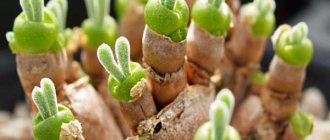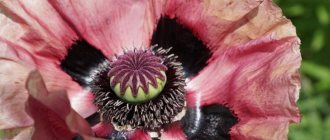Introduction
How did I first become acquainted with the beautiful flower “Bride and Groom”? My passion is growing indoor plants. They decorate the house with unusually bright flowers and variegated leaves. Watching how green pets develop is very interesting. In the spring, a friend gave me a small cutting of a plant and said that it was called “bride and groom”.
People gave a flower called campanula the romantic name “bride and groom”
I put it in water and a few weeks later, when roots appeared, I planted it in a pot. I used a soil mixture of greenhouse and leaf soil, peat and sand. The cutting took root easily and began to grow.
I placed the container with the plant in a deep tray and poured settled water into it every morning so that the plant did not lack moisture. Once every two weeks I watered it with special fertilizers for beautifully flowering indoor plants.
I pinched the quickly growing side shoots, and soon the bush became very branched and lush, numerous buds appeared on it, which bloomed one after another.
Composition of campanula and coleus
And somehow the plant became covered with the most delicate flowers. The bride and groom plant looked great on the window. In the summer I put it on the balcony, where she felt especially good.
After a long flowering at the end of summer, the campanula dropped its leaves, the shoots stretched out, I carefully cut them off and put the container in a cool place. With the onset of spring, I began to water the plants again and placed it on the windowsill. Soon new shoots appeared and already in mid-May the “bride and groom” pleased with their flowering again.
Campanula or "Bride and Groom". Home care
Campanula or "Bride and Groom". Home care
Today we will get to know Campanula . Let's find out what kind of flower it is, its cultivation characteristics and how to care for it at home .
Campanula the Bride and Groom since ancient times , is simply an incredibly beautiful and delicate indoor flower . It is also called the indoor bell because of the shape of its flowers. Campanula simply fits perfectly into absolutely any interior and will decorate any room. Campanula looks especially beautiful in a flower pot .
Previously, Campanula could be seen in almost any home. But now the beautiful flower has become a little forgotten, although in recent years it has begun to regain its popularity.
Origin of Campanula
It is believed that the homeland of Campanula is the Mediterranean, but you can find this beautiful plant in the wild nature of the Caucasus, Southern Europe, the Carpathians and also in some countries of North America. Therefore, the question of its place of origin is quite controversial.
In nature, it grows on mountain slopes, forest clearings, and on the banks of rivers and lakes. But you can grow this beauty at home.
Botanical description of Campanula indoors
When planting any plant at home, you need to know its botanical description, at least so that you are not deceived and you give your money for exactly the plant you want to purchase.
Campanula blue. Groom
The foliage of Campanula is dark green or simply green in color. The foliage has a shape similar to a clover leaf or, depending on the variety, ovoid. The leaves have a long leaf stalk.
The height of an adult plant can reach from 20 to 50 centimeters. The branches hang down, so these flowers always require hanging, they hang down like a waterfall.
Flowers come in several different shapes. They can be in the form of small or large bells, and the flowers can also be full terry. The color of the flowers is white, blue or lilac.
The root system is thin and extensive.
Planting indoor Campanula
Planting indoor Campanula is a fairly simple process and is not much different from planting other indoor plants.
Soil for planting Campanula
Campanula requires light and loose soil. It is best to purchase soil for planting it in a specialized store. Universal soil for indoor plants with peat is perfect; it is very light and quite loose, and it also contains a lot of nutrients to start its growth.
Container for planting Campanula
Campanula does not require much space to grow; on the contrary, it is much more comfortable in a small container. For ideal growth, its roots must completely entwine the earthen ball.
Campanula white. Bride
But if you notice that it is already really cramped, then choose a replacement container that is only 2 centimeters larger than the previous one. You cannot choose a larger diameter, otherwise the flower will devote all its energy to building up the horse system.
For planting Campanula, a low but wide flowerpot or hanging pot is ideal; it is these flowerpots or containers that are suitable for Campanula for its full growth and abundant flowering.
Reproduction of Campanula
Campanula can be propagated in three ways - seeds, cuttings and dividing the bush.
Reproduction of Campanula indoors by seeds
For planting, you can purchase indoor Campanula seeds at any specialty store.
Campanula terry (blue)
Take a suitable container to plant the seeds. Fill it with soil, then sow the seeds, cover them a little with soil, no more than 1 centimeter. Then water them generously.
To speed up germination, cover the container with film or glass, creating an impromptu greenhouse. When you see shoots at least 0.5 cm high, immediately remove the film or glass. While the seeds are germinating, carefully ensure that the soil is constantly moist.
Then place the container in a sunny place, but not in direct sunlight. When the seedlings reach a size of 2-3 centimeters, you can plant them in flowerpots. If you want a dense bush, then you can immediately plant the seeds in a permanent flowerpot, then they will not need replanting.
Reproduction of Campanula indoors by cuttings
It is very easy to propagate Campanula from cuttings. It is enough to cut a small branch from it, but it must be cut very low at the root heel. Then place the cutting in water for it to take root, usually within 10 days. When it has grown roots of at least 2-3 centimeters, you can start planting it in a container.
Reproduction of Campanula indoors by dividing the bush
If you already have a large enough bush, you can divide it into several parts and get several good plants at once. To do this, you need to remove the plant from the flowerpot along with the earthen lump. Then lower it into water at room temperature and carefully wash off all the soil from the horses, then rinse them under running water to remove any remaining soil. Next, carefully trying not to tear the roots too much, divide the bush into several parts. Then plant each part of the bush separately as an independent plant.
What to do after purchasing Campanula indoors?
Having bought a beautiful flowering shrub, we usually place it in the chosen place, and there it stands until the need for replanting arises. But such actions will lead to the fact that within a week you will see how Campanula begins to dry out and disappear.
Campanula terry (white)
After purchase, it simply needs to be replanted within 2-3 days. And not transfer it to another pot, but replant it, removing all the soil in which it grew.
To do this, take a suitable container or flowerpot. Carefully remove the flower with the lump, then carefully shake off the earthen lump, trying to damage the root system as little as possible.
Next, pour drainage in the form of expanded clay into the container, fill it with a little soil, lower the roots and fill it with soil to the end. Then water it generously. And send the flower to partial shade for 2 days to adapt.
Caring for Indoor Campanula
Campanula is not demanding to care for, but, like any plant, it has its own characteristics.
Campanula location and lighting
Campanula is a plant that does not tolerate heat well, so it is better to place it in the east, west or even north; it does not tolerate the south side quite well.
This flower loves a lot of light, but does not tolerate direct sunlight. Therefore, it will be best for him where he will receive enough diffused sunlight, but there will be no direct rays.
She also does not survive cold drafts well; in such a place she can die very quickly.
Fertilizing indoor Campanula
Campanula, like all indoor plants, needs regular feeding. During the flowering period, it must be fed every 10 days. Fertilizing is carried out by watering using any fertilizer for flowering indoor plants.
After flowering, fertilizing is carried out much less frequently, or rather once a month.
During the dormant period, fertilizers are not applied.
Watering indoor Campanula
Campanula needs regular, high-quality watering. During the flowering period, it is necessary to water thoroughly and not allow it to dry out. However, do not overdo it, watering is carried out from above and when the water drains into the pan it pours out; water stagnation should not be allowed.
After flowering ends, the intensity of watering decreases.
Pruning Campanula indoors
The drop needs to be pruned. But it is not the stems that need to be trimmed, but the drying bells that have already bloomed. If you leave them and wait until they fall off on their own, then by doing this you will reduce flowering. On the contrary, pruning will stimulate its flowering.
Dry shoots must also be trimmed. In winter, you can remove excess shoots if necessary. Also, for the dormant period, the shoots are shortened by a third.
Temperature conditions for room Campanula
Campanula is not a fan of heat, she does not like it. Ideal summer temperature is +20…+24°C. In winter, she feels great at a temperature of +12...+15°C. Therefore, do not try to look for a warmer place for her in winter, she will be very happy with the coolness.
The dormant period of Campanula indoors
Campanula has its own dormant period. If she has the opportunity to rest well, then later she will give you abundant and long-lasting flowering.
Campanula violet
The period when it needs rest begins at the end of October or beginning of November, depending on the end of flowering. During the dormant period, the branches are cut to a length of 14 centimeters.
It is very important to leave 4-5 internodes on the branch, it is from these that new young strong branches will then grow. At the same time, watering is reduced and the application of fertilizers is completely stopped. In March, it is necessary to inspect the growing shoots and remove all weak or fading shoots.
If you provide Campanula with a period of rest, it will bloom profusely in late April or early May and will continue to bloom until October.
Updating Campanula indoors
Even though the Campanula plant is a perennial plant, it still needs to be renewed periodically to stay healthy. It is recommended to update it every 2-3 years. This is very easy to do. It is enough to cut it or divide the bush. You can also collect the seeds yourself and plant a new plant. If you do not update, flowering will decrease every year and the flower itself will lose its decorative effect.
Is it necessary to leave the Bride and Groom together?
Campanula is also called Bride and Groom. A flower with white flowers is considered the bride, and one with blue flowers is considered the groom.
The Bride and Groom should stand together
The question often arises: are they really only planted together?
Answer: Yes, the Bride and Groom should always be close. The fact is that these are flowers of male and female forms. They have cross-pollination and that is why apart these flowers can stop flowering and begin to fade.
The second question, which often arises. Is it possible to plant them mixed in one pot?
Answer: Absolutely not. The fact is that the Bride is a stronger plant than the Groom and she will take nutrients from the Groom and he will quickly begin to fade.
This is how she is - the beautiful Campanula! Easy to care for and simply charming to bloom.
Description
Hybrid with lilac flowers
Campanula is a well-known indoor plant that belongs to the bellflower family. It can be found in the wild in many countries of Southern Europe.
A significant number of species of this plant have been cultivated and are now actively used as indoor plants.
- Campanula can be either annual or perennial.
- Plants are varied in shape, flower color, size, and there are hybrid double forms.
- Campanula equifolia is cultivated as an indoor crop. This plant is perennial, with thin shoots, sometimes creeping, in rare cases hanging down up to 25 cm long.
- The arrangement of the leaves is alternate; the leaf blades are attached to the stems with the help of elongated petioles.
- The leaf shape is heart-shaped or oval with small teeth. The leaves range in color from light green to dark green.
- The flowers are collected in inflorescences of several pieces; after flowering, a small fruit appears in the form of a box.
- Among indoor flower lovers, the most common hybrid is “Alba” (with white flowers) and “Maya” (with blue or purple flowers). People call them “the bride and groom.”
Hybrid "Alba"
All representatives of the bellflower family are not very demanding; they need the most basic things - watering, moderate lighting, and periodic feeding.
Campanula care video
It is believed that campanula radiates positive energy, filling the house with tranquility.
It doesn’t matter whether it was given to you as a wedding gift or came to you in some other way, the plant will fill your home with an atmosphere of warmth and serenity. Plant the “Groom” and “Bride” in one pot, their branches will intertwine and you will get a fabulous plant of extraordinary beauty and grace.
Follow simple rules: timely watering, good lighting and the result will not take long to arrive; from year to year the bells will delight the eye with friendly and abundant flowering.
Love your flowers, and in return they will give you a lot of positive emotions.
You can also share your secrets for caring for Campanula. If you have questions, ask them in the comments below, we will be happy to answer them.
Lighting
This plant does not require lighting. It is not recommended to grow on southern and northern windows. When grown on windowsills facing south, it is recommended to protect plants from bright sunlight by creating shading.
It is desirable that the light be bright, but diffused
If you grow campanula on a north window, there is a risk of the shoots stretching. In such plants, the distance between the leaves increases, and the decorative appearance of the plant suffers from this.
Plants love a lot of light, but are afraid of direct, burning sunlight, especially on hot summer days. Provide them with partial shade.
Temperature
Thermometer for monitoring room temperature
In spring and summer, the most optimal temperature is 23 – 26°C; in winter, it is better to keep plants at a lower temperature from plus 12 to plus 14°C.
In winter, do not leave the plant on the windowsill under which the heating radiator is located; it is better to move it to a cool place, but keep in mind that the lower limit is +12°C. Do not be afraid of temperature changes, as these plants tolerate them quite well.
Campanula has the ability to adapt to different temperatures, and thanks to this property, a flowering plant can be transferred from the room to the balcony, back and forth, without fear of any negative consequences.
How to make Campanula bloom
Their flowering period occurs in May-June, lasting several months, gradually fading by autumn. To stimulate the formation of new buds, systematically plucking old, fading flowers from the bush is carried out.
A flower can be made to bloom artificially
If the bush does not bloom at all, it is important to provide it with a preliminary period of rest by placing it in a cool place, such as a basement, or taking it out onto a glazed balcony. At the same time, it is important to provide it with bright and long-lasting lighting; if it is winter, turn on an artificial lighting lamp.
Watering and humidity
Campanula loves water
As for watering, its scheme is classic: abundant in summer, moderate in winter.
1Spraying is recommended, especially in dry weather, and in summer during heat.
2Do not allow the soil to become excessively waterlogged. To avoid water stagnation, use drainage in the form of expanded clay balls.
3 In autumn and winter, limit watering to a minimum.
4In spring and summer, these plants need to be fed with complex fertilizers every 3 weeks.
5The best watering is from below.
Fertilizers
The use of complex fertilizers will allow you to obtain flowers with bright colors
Use mineral and organic fertilizers 2 - 3 times every thirty days (spring and summer). Water once every two weeks with special fertilizers for beautifully flowering indoor plants.
Diseases and methods of combating them
Perennial garden campanula - planting and care
Sometimes Campanula can be affected by certain diseases and pests. How they manifest themselves and how to deal with them:
- Root rot. Rot appears on the leaves and the root part of the stem, and the leaves begin to turn yellow. It is difficult to revive the plant - the damaged parts are removed and treated with chemical antifungal drugs.
- Spider mite. The foliage turns yellow and withers, then dies and falls off, and a cobweb is visible on the reverse, back side. It is best to wash the plant with soap and water and treat it, for example, with a preparation such as Actellik. Prepare the solution according to the instructions and process it 2-3 times at weekly intervals. For prevention purposes, it is worth spraying the plant with a soap solution.
- Shield aphid. Brown tubercles appear on the foliage, the affected leaves turn pale and then dry out. To remove scale insects, wash under running water with soapy foam.
Pests that attack Campanula
These are the most common plant pests. To prevent their occurrence in the future, it is important to consider a number of rules for successful prevention:
- new plants are kept in quarantine for at least a month in a separate room;
- it is important to regularly inspect the plant and identify diseases in the early stages;
- placing plants as far as possible from each other, preventing infection and ensuring natural air circulation;
- it is important to ventilate the room every day, spray the plants, remove dust;
- Observe the watering regime correctly and use only clean flowerpots and steamed soil for planting.
Also, for prevention, it is worth periodically adding potassium permanganate to the water, obtaining a weak solution of a pale pink color.
Transfer
At the end of summer, the growing season of the plant stops, and it requires preparation to enter a state of dormancy. The most acceptable method of propagation is vegetative : by cuttings, green shoots, by dividing the bush into several parts.
Plants need to be replanted more often. Most ornamental plants like to be replanted fairly frequently.
Repotting indoor plants
The fact is that when grown for a long time, no matter how beautiful the plant is, it loses its decorative effect over time, the shoots lengthen, and the distance between the leaves increases. It no longer looks so chic and fluffy, as if it is “balding”.
To avoid this, take cuttings and form new bushes from the resulting cuttings. After a long flowering at the end of summer, Campanella sheds its leaves, the shoots become elongated, and the decorative effect decreases.
Campanula pruning
When the plant's dormant period begins, around the end of October - beginning of December, you can shorten the stems of the plant to 10 - 12 cm. It is quite possible that after such pruning your campanula will bloom, if, of course, you leave it to overwinter in a sunny window.
At the beginning of spring, inspect the plant, remove dried stems and leaves and trim the shoots again, leaving about 5 cm in length. The fact is that at the base of the shoots there are many dormant buds hidden, from which new strong shoots will appear with the onset of spring.
Reproduction
If the plant has grown enough and does not fit into the volume of the container, it must be divided into several parts. Carefully remove the bush from the pot with a lump of earth. Using a sharp knife, the rhizome is cut into pieces.
Don’t forget to treat the cut areas with crushed wood charcoal. Plant the resulting parts in new containers of smaller volume. It is not recommended to immerse plants deep into the soil. Immediately after transplanting, provide the plant with plenty of water and shade.
Using cuttings
Campanula cuttings
- Cuttings are very easy to obtain. When pruning elongated shoots, use the lower parts for rooting.
- Rooting occurs best in a mixture of peat and sand.
- For cuttings, it is necessary to provide greenhouse conditions; it is advisable to cover the plant with a polyethylene cap and regularly spray it with water from a spray bottle.
- The optimal rooting temperature is 20 – 24°C.
- After the shoots grow to 7 - 10 centimeters, pinch their tops. This procedure provokes the appearance of additional shoots. Your bushes will be more branched.
Cuttings can be resorted to in the summer. They will grow over the summer and autumn, but by the beginning of winter the green part needs to be cut off and the flower allowed to rest. Already in the first spring after transplantation, campanula can bloom with proper care and timely feeding.
Green shoots
This type of vegetative propagation should be resorted to in the spring, when young green branches grow at the campanula. They can be cut and rooted.
How to do it correctly:
1Separate the green shoot from the “heel”
2Plant it in a mixture of loose peat soil and sand
3Cover with plastic wrap
4Ensure greenhouse conditions
5Keep the container with young shoots in a cool place at a temperature of plus 12-15 degrees
6Don’t forget to spray and ventilate your miniature greenhouse every day
Mini greenhouse for rooting cuttings
Campanella takes root quite quickly; after two weeks, small roots form. After the plants begin to actively grow vegetative mass, move them to a brighter and warmer place.
When the plant reaches a height of ten centimeters, it is necessary to pinch it so that it begins to branch and bush.
Propagation by seeds
The seeds of this plant are very small; they need to be planted superficially in small bowls filled with soil mixture. It is advisable to cover the seeds with a thin layer of soil on top. For seeds during the germination period, it is necessary to provide a greenhouse effect, wrap the top with plastic film or glass.
Sprouted seeds
Be sure to provide periodic ventilation to prevent excess condensation from accumulating. After the third leaf appears, pick up the seedlings, do not forget to pinch, this will allow you to get a branchy bush. Plants grown from seeds usually bloom in the second year.
Growing by cuttings
If we talk about propagation by cuttings, the description of the technique involves cutting a shoot from the mother bush, with 2-3 leaves. Place it for 8–10 hours in a weak, pale solution of potassium permanganate and then put it in clean water, keeping it until the first roots appear.
Rooting Campanula cuttings
The soil is prepared from peat and sand in equal proportions, rooted cuttings are planted in it to a depth of 2–3 cm, and covered with film. Spray the cuttings periodically, at least once a week until they are completely rooted.
Diseases and harmful insects
At home, plants are much less susceptible to diseases and pests. However, they are not 100% protected. If not properly cared for, a number of problems can arise.
Gray rot
With constant waterlogging of the soil, when there is no drainage in the flower pot, the water stagnates, which in turn leads to acidification of the soil.
Gray rot thrives in damp soil. When affected by gray rot, plants wither and the root system begins to rot.
An unpleasant odor appears in the room where the flower affected by gray rot is located. Sometimes, when the rotting goes very far, the flower can no longer be saved.
In any case, first of all, you need to cut off the rotten twigs and leaves and throw away the old soil. Transplant the flower into new light soil, reduce watering.
Fusarium
If temperature conditions are not observed, as well as in the absence of light, the viability of the plant decreases. Sometimes fusarium can be observed on the “bride and groom” flower; it is accompanied by yellowing of the tips of the leaf blades.
In severe forms, the leaves die and the shoots wither from the root.
Heart rot
If you find brown heart-shaped spots with a gray coating on the leaves, then it is likely that the plant has developed brown heart-shaped rot. This disease is caused by pathogenic microscopic fungi.
To combat them, fungicides are used, while watering is reduced and the plants are regularly ventilated.
Spider mites, aphids, scale insects
If the plant is in a dry room, aphids or scale insects may appear. At the first symptoms of these diseases, treat the plants with insecticide preparations. A proven folk remedy against aphids and scale insects is a soap solution.
Spider mites are the scourge of many indoor plants. Use broad-spectrum insecticides to combat it.
An effective drug against aphids
Most often, the companula is affected by aphids
Most often, companula is affected by aphids. Aphids multiply very quickly, so control should begin when they first appear. It is better to use systemic preparations that not only destroy the pest during treatment, but also continue to act for some time in the plants themselves.
There is a drug "Biotlin" designed to protect against sucking pests.
The treatment solution is prepared at the rate of 0.5 ml of the drug per 1 liter of water. Penetrating into the plant within a few hours, the drug will protect it for at least two weeks.
How to propagate yourself
Hobbyists reproduce the Bride in several ways:
- cuttings;
- planting young shoots;
- dividing the bush.
For the first method, in the spring, several strong stems are cut from the lower part of which sections 10-15 cm long are prepared. The sections are immersed for several hours in a growth stimulator, and then rooted in sand under a cover of transparent material. The appearance of new leaves indicates that the plant has taken root. After this, you can transplant the young campanula into a separate pot of suitable size.
Advice. When the bell reaches a height of 10 cm, pinch off the top. This forces the Bride to branch vigorously, resulting in a lush bush.
In the spring, when the Bride is growing rapidly, you can find shoots that appear a little further from the base of the bush. They are carefully dug up and transplanted into nutrient soil. At first, the planting is covered with film or glass, while providing daily ventilation. After the formation of new leaves, the cover is removed and they begin to care for the young plant as for an adult specimen.
Advice. When planting the Bride and Groom in one container, it is advisable to divide the soil between them with a partition made of suitable material, since white campanula is a stronger plant and over time can completely displace the Groom.
Dividing a bush is the easiest way to propagate an indoor bellflower. It is carried out simultaneously with the transplant according to the following points:
- Moisturizes the soil well.
- Carefully dump the plant along with the lump of soil from the pot.
- Use a sharp knife to cut into fairly large pieces.
- The cut areas are sprinkled with ash, which will prevent rotting.
- Plant the cuttings in prepared containers.
The plant is easy to propagate
Varieties
Terry hybrids
Terry hybrids
Terry hybrids Recently, the most beautiful hybrids of terry campanula have appeared. The terry hybrid was bred by crossing the Carpathian bellflower and Campanula sparrowfolia.
Terry companula looks like a small bush dotted with large double flowers. The stems are shortened, the leaves are densely arranged.
It should be remembered that double forms of flowers, as a rule, are more finicky and do not take root with all amateur gardeners.
Carpathian campanula
Carpathian Campanula in natural conditions
Carpathian Campanula This plant can grow both in open ground and indoors. This is a herbaceous plant that resembles a bush.
Its height can reach 30 cm. The leaves are located below in the form of a basal rosette; they are oval in shape.
The flowers are quite large, up to 6 cm in diameter, and come in white, blue, lilac and violet colors. Under natural conditions, this plant is found in the Carpathian mountains.
It blooms from May to August.
Campanula after flowering: dormant period
At the end of the period of active flowering, the plant should be provided with rest, from approximately September to early March. During the rest period, you should follow these recommendations:
- in October, sanitary pruning of the bush is carried out, removing dry shoots and leaves - this will allow the root system to retain maximum nutritional components and delight with abundant flowering in the spring;
- in December, shoots are trimmed, cutting them to a height of 12–15 cm, preserving the plant’s strength until spring;
- in March, shoots that have grown over the winter are pruned to a height of at least 5 cm above the ground.
Also, during the dormant period, it is worth reducing watering - it is carried out once every 2 weeks, moving the plant itself to a cool room, with sufficient lighting, but away from heat sources. No fertilizing is applied during the dormant period, thereby not stimulating the awakening and growth of flower shoots.
In conclusion, it can be noted that terry campanula is not just a beautiful plant, but also a flower that brings prosperity and joy to the house. True, provided that it is properly cared for.











